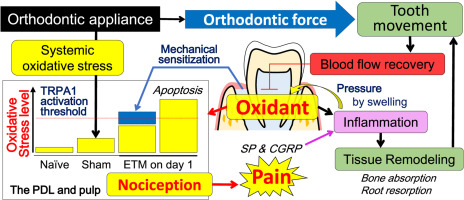当前位置:
X-MOL 学术
›
Free Radical Bio. Med.
›
论文详情
Our official English website, www.x-mol.net, welcomes your
feedback! (Note: you will need to create a separate account there.)
Orthodontic force-induced oxidative stress in the periodontal tissue and dental pulp elicits nociception via activation/sensitization of TRPA1 on nociceptive fibers.
Free Radical Biology and Medicine ( IF 7.1 ) Pub Date : 2019-12-20 , DOI: 10.1016/j.freeradbiomed.2019.12.016 Aoi Morii 1 , Yuichi Miyamura 2 , Misa I Sago 3 , Masahiro Mizuhara 3 , Takemi Shikayama 4 , Mako Naniwa 5 , Suzuro Hitomi 5 , Izumi Ujihara 5 , Kayoko N Kuroishi 3 , Kaori K Gunjigake 3 , Momotoshi Shiga 3 , Yasuhiro Morimoto 6 , Tatsuo Kawamoto 3 , Kentaro Ono 5
Free Radical Biology and Medicine ( IF 7.1 ) Pub Date : 2019-12-20 , DOI: 10.1016/j.freeradbiomed.2019.12.016 Aoi Morii 1 , Yuichi Miyamura 2 , Misa I Sago 3 , Masahiro Mizuhara 3 , Takemi Shikayama 4 , Mako Naniwa 5 , Suzuro Hitomi 5 , Izumi Ujihara 5 , Kayoko N Kuroishi 3 , Kaori K Gunjigake 3 , Momotoshi Shiga 3 , Yasuhiro Morimoto 6 , Tatsuo Kawamoto 3 , Kentaro Ono 5
Affiliation

|
Orthodontic patients complain of pain for the first few days after insertion of appliances. Mechanical force has been reported to produce oxidants in periodontal ligament (PDL) cells. It has not been studied whether orthodontic force-induced oxidative stress elicits nociception. Herein, we focused on the role of the oxidant-sensitive channel TRPA1 on nociception in orthodontic pain. In a rat model of loaded orthodontic force between the maxillary first molar and incisor, the behavioral signs of orofacial nociception, facial rubbing and wiping, increased to a peak on day 1 and gradually diminished to the control level on day 5. Administration of free radical scavengers (Tempol and PBN) and TRPA1 antagonist (HC-030031) inhibited nociceptive behaviors on day 1. In the PDL, the oxidative stress marker 8-OHdG was highly detected on day 1 and recovered on day 5 to the sham-operated level. The dental pulp showed similar results as the PDL. TRPA1 mRNA was abundantly expressed in the trigeminal ganglion relative to PDL tissue, and there were TRPA1-immunopositive neuronal fibers in the PDL and pulp. In dissociated trigeminal ganglion neurons, H2O2 at 5 mM induced a Ca2+ response that was inhibited by HC-030031. Although H2O2 at 100 μM did not yield any response, it enhanced the mechanically activated TRPA1-dependent Ca2+ response. These results suggest that oxidative stress in the PDL and dental pulp following orthodontic force activates and/or mechanically sensitizes TRPA1 on nociceptive fibers, resulting in orthodontic nociception. Later, the disappearance of nociception seems to be related to a decrease in oxidative stress, probably due to tissue remodeling.
中文翻译:

正畸力诱导的牙周组织和牙髓中的氧化应激通过激活/敏化伤害感受纤维上的 TRPA1 引发伤害感受。
正畸患者在插入矫治器后的最初几天会抱怨疼痛。据报道,机械力会在牙周韧带 (PDL) 细胞中产生氧化剂。尚未研究正畸力诱导的氧化应激是否会引起伤害感受。在这里,我们专注于氧化敏感通道 TRPA1 在正畸疼痛中对伤害感受的作用。在上颌第一磨牙和切牙之间加载正畸力的大鼠模型中,口面部伤害感受、面部摩擦和擦拭的行为体征在第 1 天增加至峰值,并在第 5 天逐渐减弱至对照水平。清除剂(Tempol 和 PBN)和 TRPA1 拮抗剂(HC-030031)在第 1 天抑制伤害性行为。在 PDL 中,氧化应激标志物 8-OHdG 在第 1 天被高度检测到,并在第 5 天恢复到假手术水平。牙髓显示出与 PDL 相似的结果。TRPA1 mRNA相对于PDL组织在三叉神经节中大量表达,PDL和牙髓中有TRPA1免疫阳性神经元纤维。在分离的三叉神经节神经元中,5 mM 的 H2O2 诱导了被 HC-030031 抑制的 Ca2+ 反应。尽管 100 μM 的 H2O2 没有产生任何反应,但它增强了机械激活的 TRPA1 依赖性 Ca2+ 反应。这些结果表明,正畸力后 PDL 和牙髓中的氧化应激会激活和/或机械地使伤害感受纤维上的 TRPA1 敏感,从而导致正畸伤害感受。之后,
更新日期:2019-12-20
中文翻译:

正畸力诱导的牙周组织和牙髓中的氧化应激通过激活/敏化伤害感受纤维上的 TRPA1 引发伤害感受。
正畸患者在插入矫治器后的最初几天会抱怨疼痛。据报道,机械力会在牙周韧带 (PDL) 细胞中产生氧化剂。尚未研究正畸力诱导的氧化应激是否会引起伤害感受。在这里,我们专注于氧化敏感通道 TRPA1 在正畸疼痛中对伤害感受的作用。在上颌第一磨牙和切牙之间加载正畸力的大鼠模型中,口面部伤害感受、面部摩擦和擦拭的行为体征在第 1 天增加至峰值,并在第 5 天逐渐减弱至对照水平。清除剂(Tempol 和 PBN)和 TRPA1 拮抗剂(HC-030031)在第 1 天抑制伤害性行为。在 PDL 中,氧化应激标志物 8-OHdG 在第 1 天被高度检测到,并在第 5 天恢复到假手术水平。牙髓显示出与 PDL 相似的结果。TRPA1 mRNA相对于PDL组织在三叉神经节中大量表达,PDL和牙髓中有TRPA1免疫阳性神经元纤维。在分离的三叉神经节神经元中,5 mM 的 H2O2 诱导了被 HC-030031 抑制的 Ca2+ 反应。尽管 100 μM 的 H2O2 没有产生任何反应,但它增强了机械激活的 TRPA1 依赖性 Ca2+ 反应。这些结果表明,正畸力后 PDL 和牙髓中的氧化应激会激活和/或机械地使伤害感受纤维上的 TRPA1 敏感,从而导致正畸伤害感受。之后,










































 京公网安备 11010802027423号
京公网安备 11010802027423号